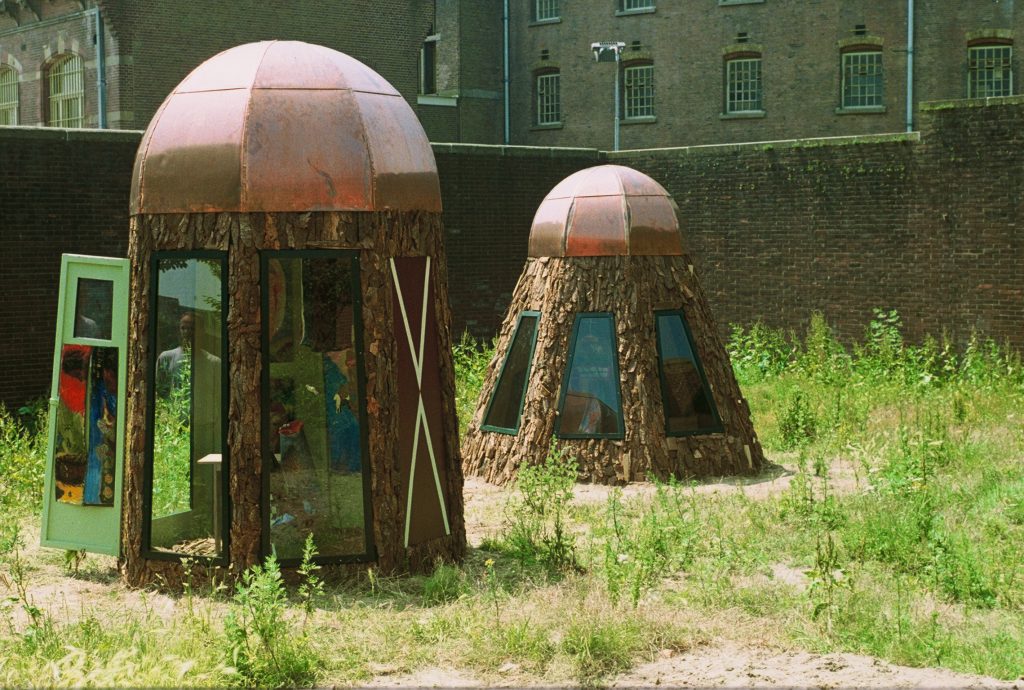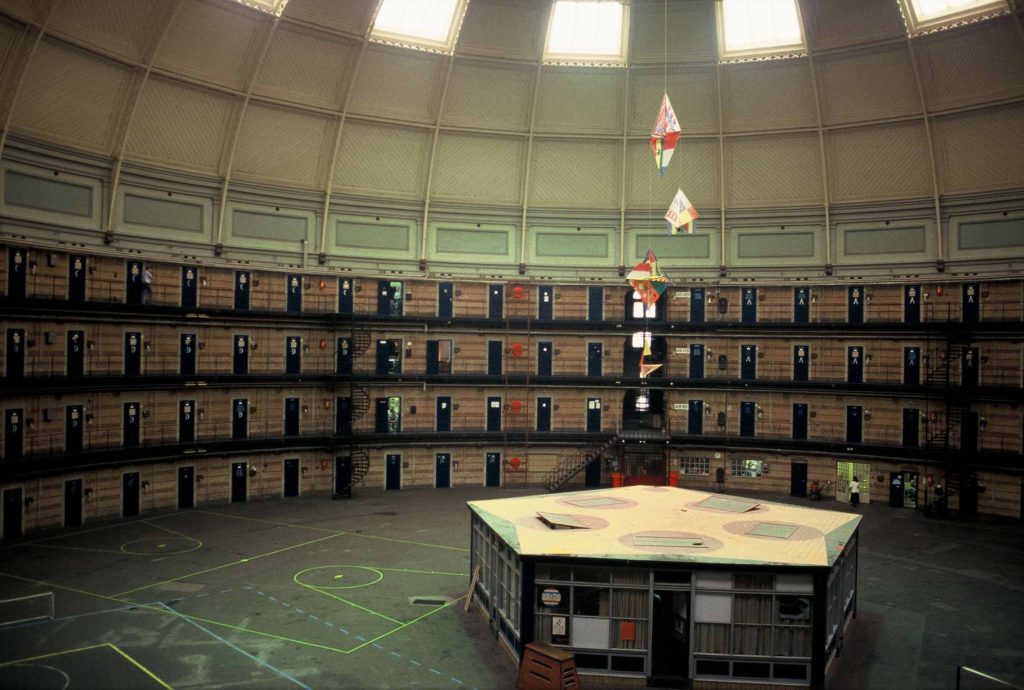Irene en Christine Hohenbüchler, Project zonder titel, 1993

Afb. 1: Irene en Christine Hohenbüchler, Project zonder titel, 1993, buiten de Koepelgevangenis. ©Irene en Christine Hohenbüchler
In de drie maanden naar aanloop van Sonsbeek ’93 maken de zussen Irene en Christine Hohenbüchler (1964) kunstwerken samen met gevangenen in de Koepgevangenis in Arnhem, onder toezicht van een bewaker in een hiervoor speciaal ingerichte ruimte in de gevangenis. Het eindresultaat wordt deels pal naast de Koepelgevangenis getoond aan het publiek, in drie simpele paviljoentjes (afb. 1) en deels in de gevangenis zelf (afb. 2). Behalve de kunstwerken is er foto- en videomateriaal dat uitleg geeft over de bijzondere samenwerking.[1]
De uitwisseling met mensen die zich aan de onderkant van de samenleving bevinden staat centraal in veel projecten van Irene en Christine Hohenbüchler. Zo werken ze vóór Sonsbeek ’93 samen met verstandelijk gehandicapten van de kunstwerkplaats Lienz in Tirol. Hun ervaringen en de kunstwerken van de gehandicapten worden gebundeld in Herbar (1991). Daarnaast bezoeken ze psychiatrische inrichtingen in Duitsland. Tijdens hun werk zal hun persoonlijke achtergrond ongetwijfeld hebben meegespeeld; hun jongere zus Heidi kampt namelijk met depressiviteit en de moeder van de zussen is al lang in therapie. In een interview dat opgenomen is in de tentoonstellingscatalogus van Sonsbeek ’93 praten ze hier beide openlijk over.[2]

Afb. 2: Irene en Christine Hohenbüchler, Project zonder titel, 1993, in de Koepelgevangenis. ©Irene en Christine Hohenbüchler
De samenwerking in Arnhem is zowel voor de zussen als de gedetineerden compleet nieuw. De tweeling vindt het belangrijk dat de gevangenen zoveel mogelijk zichzelf kunnen zijn en hun eigen beslissingen nemen. Ze kunnen bijvoorbeeld zelf ervoor kiezen om te komen, bepalen wat ze willen creëren en welke muziek wordt opgezet. Sommige gevangenen komen iedere dag, terwijl andere maar een paar uur per week bezig zijn. Voor de zussen staat het contact tijdens het werkproces voorop, waarbij ernaar gestreefd wordt om elkaar te motiveren en inspireren. Hoewel ze de mensen intensief begeleiden, zien Irene en Christine zichzelf niet als creatieve therapeuten of docenten maar als ‘animators’.[3] Uit de dagboekstukken van Christine in de catalogus blijkt dat het in werkelijkheid niet altijd makkelijk is. “Voor de meeste is het alleen maar een last om zich geconcentreerd met iets bezig te houden”, schrijft ze.[4] Als gevolg is ze soms erg onzeker over zichzelf en het project.
De getoonde kunstwerken, vooral schilderijen, markeren het eindpunt van een maandenlange samenwerking. Het blijft echter onduidelijk wat is gemaakt door de kunstenaressen en de gedetineerden.[5] Artistiek auteurschap speelt dus geen enkele rol; het werkproces is het allerbelangrijkste.
[1] “De Hohenbüchlerzusjes in Koepelgevangenis”, in: De Kunsten, p. 43.
[2] I. en C. Hohenbüchler en E. Jelinek, in: Ten. cat. Arnhem (Sonsbeek ‘93), 1993, pp. 254-260.
[3] “De Hohenbüchlerzusjes in Koepelgevangenis”, in: De Kunsten, p. 43.
[4] C. Hohenbüchler, in: ten. cat. Arnhem (Sonsbeek ‘93), 1993, p. 267.
[5] “De Hohenbüchlerzusjes in Koepelgevangenis”, in: De Kunsten, p. 43.
